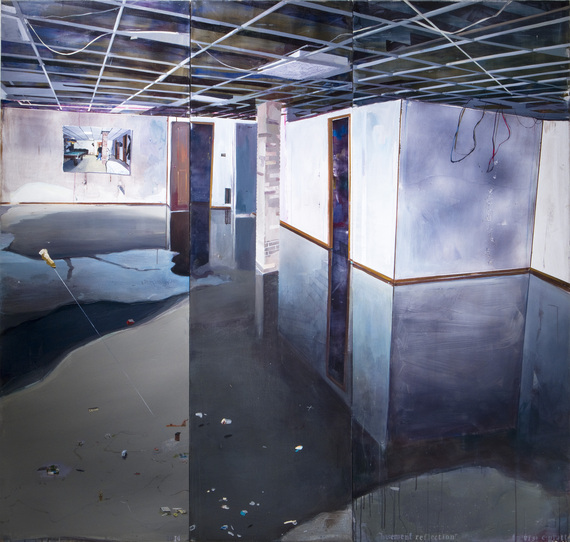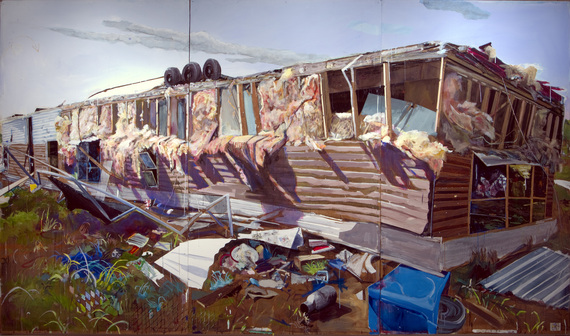Theo: I don't think God bargains.
Miriam: Oh yes he does... He bargains all right...If He wants belief He'd better provide some evidence.
Theo: That He exists?
Miriam: That He cares.-from P.D. James, Children of Men>
Recollections of a natural disaster, both awesome and disconcerting, are on view at Kansas City's Leedy-Voulkos Art Center. Somewhere amidst the wreckage there is a parable. We ask for proof of a God. When a sign is given, we grieve for having gotten what we asked for. The Joplin Paintings: Part 1 and Part 2 are a series of exquisitely rendered paintings by artist Travis Pratt depicting the aftermath of the May 22, 2011 Joplin tornado disaster and how his extended family was affected. Created on a scale to show the event's enormity as one might feel witnessing any catastrophic event, most pieces are so large it allows us to stand up close and bear witness where we might otherwise turn away. Infinite detail is not blurred nor covered up. It feels, unfortunately, as if one is there. Part 1: (which ran October 1 - November 3, 2014) and Part 2 (currently on exhibition January 2 - January 31, 2015) are Pratt's spot-on renderings of the aftermath.
Throughout both exhibitions, The Joplin Paintings are a convocation of shape, line and color that in no way diminishes the effects of a natural disaster, but gives permission to enjoy what he creates without substituting empathy for beauty.
Critically speaking, these paintings are excellent. They offer nothing but the brutal truth. Even when his imagery leans towards abstraction, Pratt doesn't overburden it with more dramatization than already exists.
It is that peculiar middle space of no caution between careful examination and viewing with rose-colored glasses which Pratt uncovers, something news reports usually fail to uncover. Painting through the trauma might be the only way one can finally achieve a catharsis of sorts. Though he wasn't there during the event, Pratt translates the pain and suffering of his family (aunts, uncles, cousins and grandfather) with both tenderness and pragmatism.
Catching a last glimpse of a structure before it's finally razed for a replacement, the vulnerability of a precariously stilted barn, a tangled web of tree branches, all uncover an unexpected beauty amongst the destruction.
In the triptych panel Tidal Loan (2013, 80" x 80.5"), there are moments of extraordinary beauty and cruelty. It is these colliding strains where Pratt is most successful. It appears everything has been flattened and forced upside down in an easterly direction. Tree branches frame umpteen layers of something that stood the day before, including an upside-down car beneath. It continues in infinitesimal detail, a person facing the miasma of debris isn't dwarfed, but it is understood the eventual clean up will be a Sysphean task. While Joplin has since regained a semblance of normalcy on the surface; the emotional wreckage, on the other hand, can still be very real. Every time a tornado siren goes off, hearts stop for a moment.
Part 1 provoked an emotional intensity on a large scale. His imagery is filled with realism; line and color that recall the candied effervescence of Wayne Thiebaud, which might seem cruel, but God, Mother Nature, whomever you call upon to place blame, is a cruel entity. Much calmer, less chaotic, less color, there is a finality in Part 2 that isn't so much muted as it is faded and worn, something still held over but finally relegated to a memory so there is room to carry on.
Oscar's Old Place (2013, 42" x 40") and Justin's Old Place (2013, 82" x 144"), two former dwellings that heighten such feelings. The latter completely pulled inside out, insulation pouring through any opening possible and the former just flat-out gone. In Part 2, Porch (2013, 12" x 14"), begins to fade from memory. A black and white image that allows you to forget something stood there in full and is either rebuilt or gone entirely. Looking at these layers of wood, stone, brick and personal effects, I am reminded of artist Sylvia Plimack Mangold's Detail for Ruler Reflection (1976), an incredibly simple and structured piece that proves fitting nature into geometry is, like the math itself, a complicated endeavor. In this case it's finding geometry in nature. Abstract forms appear, but before they can be seen viewers first confront an immediacy of destruction and figure out to look past that and see the destruction not so much disappeared, but repaired.
Pratt shows us that the tornado itself wasn't the only pivot point but the days, weeks and months afterward as well. Pratt doesn't lavish his paintings with a lot of personal melodrama, but you look at a destroyed house and know that this was once someone's home and we shouldn't be looking at it. Then one day, where a structure once stood, is now a cleared field or maybe something new. It's disconcerting, but in the afterlife of disaster, and whatever entity one might believe in, a future exists.
The Joplin Painting: Part 1 and Part 2 can also be seen on YouTube.



